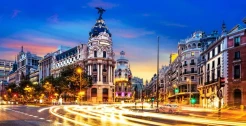
Gay Madrid City Guide
Planning a trip to Madrid? Then our gay Madrid city guide page is for you
Book A Travel Gay Approved Hotel
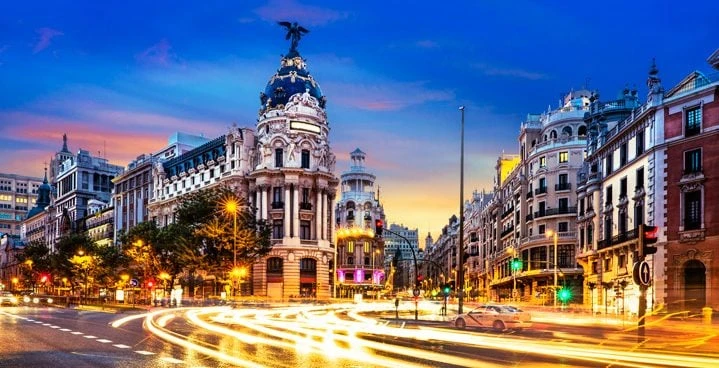 Gran Via
Gran Via
Gay Madrid
Madrid is the capital and largest city of Spain, spanning a total of about 600 km². The city is located on the Manzanares River in the centre of the country.
The metropolitan area is the third-largest in the European Union (after London and Paris) and has a population of around 6.5 million.
Madrid is the political, economic and cultural centre of Spain and ranks among one of the greenest European cities. While the city has a modern infrastructure, it has retained the look and feel of its historic neighbourhoods and streets.
Madrid is also famous for its legendary nightlife and party scene.
Gay Rights in Spain
Spain is one of the most progressive countries in the world when it comes to gay rights, although this reflects dramatic changes that have only occurred in recent decades.
The age of consent is 16 for everyone. Same-sex marriage is legal. Same-sex couples can adopt children. Gay men can serve openly in the military. There are anti-discrimination laws for employment, provision of goods and services and against hate speech.
The gay community is highly visible with major gay pride celebrations each year in Madrid and Barcelona.
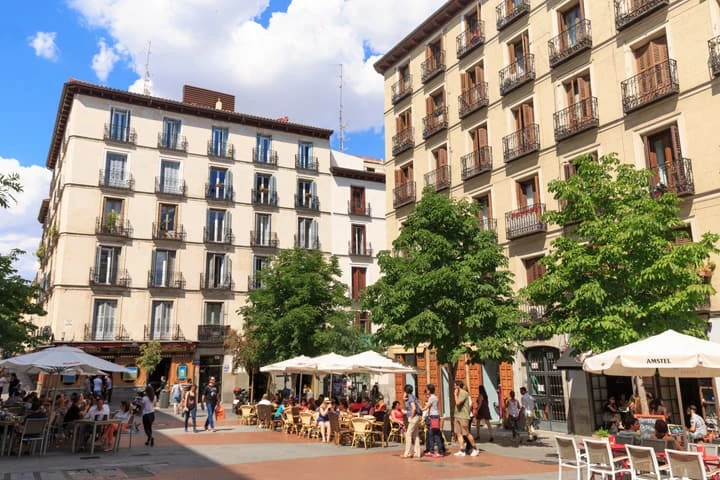 Chueca district
Chueca district
Gay Scene in Madrid
The main gay area is in the Chueca district, close to Gran Via. This very popular district has a high concentration of gay bars, clubs and shops. This neighbourhood is relatively compact, with most of the establishments close to Plaza Chueca or Calle Pelayo. Read More: Madrid Gay Bars, Madrid Lesbian Bars.
Chueca is an incredibly "open" area where you are likely to see guys holding hands, occasionally kissing and generally living a life you could only dream of in some other cities.
The nightlife starts very late in Madrid. The bars don't get busy until after midnight and people move on to a nightclub around 4 am. Many gay bars have dark rooms in the back. More hardcore venues with dress codes for cruising and fetish fans are also common. Use our Madrid Gay Map to get a general feel for the layout of the city and the location of the gay venues.
Every summer, Madrid hosts one of the largest and most vibrant Gay Pride events in Europe that attracts, literally, hundreds of thousands of spectators.
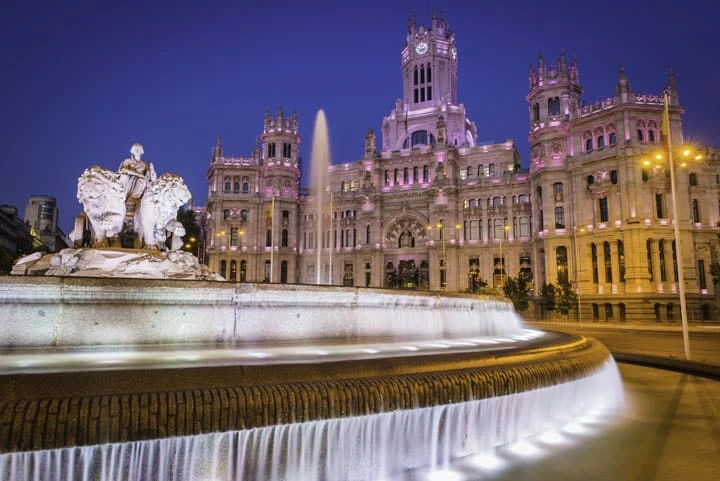 Plaza De Cibeles
Plaza De Cibeles
Getting to Madrid
Madrid Barajas International Airport (MAD) is located 13km from the city center. It is one of the largest airports in Europe and is served by numerous airlines, as well as being the home base for the Spanish national carrier, Iberia.
The airport has four terminals, including Terminal 4 - a new terminal that has won architectural awards for its stunning design.
Getting from the Airport to the City
By taxi
The most convenient method for tourists to get to the city is by taxi. These are readily available immediately outside the terminals. A flat rate fee of €30 applies to all central Madrid locations.
By train
The Metro de Madrid (Madrid's Subway) is one of the best and least expensive metros in Europe. Stamping the ticket one time allows you to use the Metro network as long and as far as you like (within the Metro zone). Announcements in the metro are made only in Spanish, although signs are bilingual in Spanish and English. Line 8 runs from Terminal 4 into the city and costs €4.50-5 (you can connect via stations on the metro network).
By bus
Buses 200 and 101 run from the airport to the city between 06:00 to 23:00 daily however the line 203 or Exprés Aeropuerto runs 24 hours 365 days a year and there is a night bus N27 EXPRÉS. Buses are equipped with a free WiFi facility (EMTmadrid).
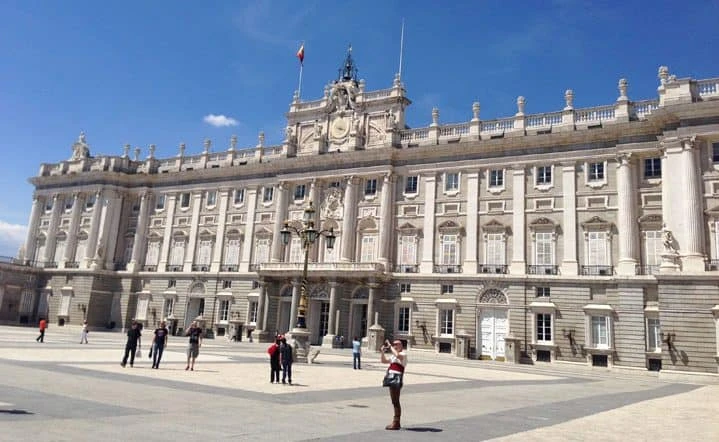 Madrid Royal Palace
Madrid Royal Palace
Getting around Madrid
On foot
Whilst not flat, walking is a great option for the very centre of the city. Many side streets are pedestrianised and some even have massive shades to keep the intense summer heat in check. Make sure you take a cap.
By metro and bus
Madrid has an extensive, integrated bus and metro network. Fares start at a very reasonable €1.50. 1,2, 3, 5 and 7-day tourist tickets are available with prices starting from €8.40 per day. The Metro operates from 6 am to 1.30 am daily.
Where to Stay in Madrid
Most gay travellers stay near the Chueca gay district, Gran Via and Sol/Cortes. These central areas offer a great base from which to explore the best sights and gay scene in Madrid. Some hotels are gay-owned and very gay-friendly.
For our list of recommended hotels in Madrid, visit our Gay Madrid Mid-Range + Budget Hotels and Gay Madrid Luxury Hotels pages.
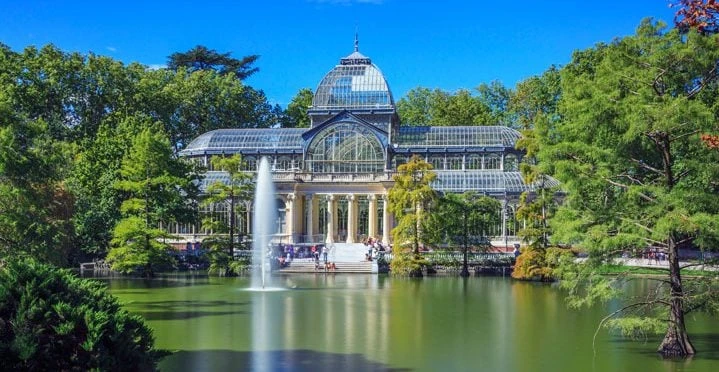 Crystal Palace at Retiro Park
Crystal Palace at Retiro Park
Things to See & Do in Madrid
- Prado Museum - features one of the largest art collections in the world including pieces by many great masters such as Goya, El Greco, Rubens and Bosch.
- Retiro Park (Parque del Retiro) - a large urban park with a beautiful lake, the Glass Palace, and the fountain of the Fallen Angel. Great for picnics or simply walking around.
- Thyssen-Bornemisza Museum - beautifully designed museum with a definitive collection of 12th to 20th-century art.
- Royal Palace of Madrid - stunning grandiose rococo palace with opulently gilded rooms.
- Sorolla Museum - a lesser-known museum with a great collection of early 20th-century art.
- Cava Baja - a great neighbourhood with numerous restaurants and bars.
- Cybele's Fountain - one of the most important fountains in Madrid.
- Cerralbo Museum - incredible mansion with a gorgeous collection of art.
- Parque El Capricho - a beautiful, immaculate park with plenty of wildlife.
- Salamanca - a nice upscale neighbourhood that's worth a visit.
Read More: Things To Do In Madrid.
Visa
Spain is within the Schengen visa area. If travelling from outside Europe, you should check to see if you require a Schengen visa.
Money
The currency in Spain is the Euro. Cash dispensers are widely available. Credit and debit cards are widely accepted. Photo ID may be required if paying by card in some shops.
Electricity
220 volts, using standard European 2-round pin plugs.
Join the Travel Gay Newsletter
Have we got something wrong?
Are we missing a new venue or has a business closed? Or has something changed and we have not yet updated our pages? Please use this form to let us know. We really appreciate your feedback.